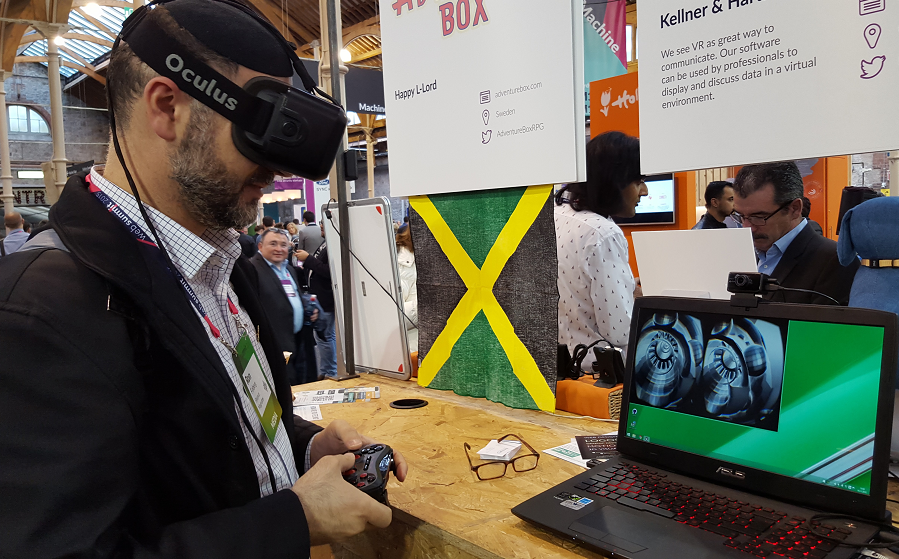It’s been several weeks since our last Fintech Spotlight column so I thought it was about time to fire up again what should be a weekly column. As usual, the column’s focus is on featuring interesting trends or startups in the fintech world. For this week, the column is less about the current fintech scene, but about future technology which may take a few more years to really develop.
Walking around the halls of Web Summit last week, the event was a showcase of both the present and future of technology. If you like ed-tech, there were at least 100 startups presenting their wares. The same was true for nearly every sector such as eCommerce, ad-tech, design, social and software development. Fintech also made itself present, most notably with the Money Summit panels and talks on the last day. Sadly though, fintech startups were in the minority (my assumption is that as a tech conference, many fintech startups probably saw little value in attending the event and are more focused on industry specific conferences centered around trading or banking).
Among the emerging technologies, arguably the ones with the greatest buzz were virtual reality. In addition to startups showcasing their virtual reality wares, Ford, Audi, Google and Facebook all had long lines of attendees wanting to try out their virtual reality devices.

Andrew Rossiter, CTO of ADS Securities
In terms of fintech, it remains to be seen how virtual reality will be integrated within the industry, but the first few seeds are beginning to be sown. Use cases that are currently being discussed have revolved around education and data visualization. Even though we are arguably still years away from when virtual reality has a noticeable impact on the industry, early adopters and technologists are already experimenting with the technology.
Among early examples of virtual reality being noted as a potential game changer for finance was at last year’s Finance Magnates' London Summit. During the 2014 event’s Technology Panel, when asked about examples of technology that the panelists were excited about, Andrew Rossiter, CTO of ADS Securities hinted to the potential of virtual reality. He stated that he believed the technology would have a similar impact to that of the internet.
Data Visualization
Taking a closer look at data visualization, the use of virtual reality would simply be a continuation of current trends in the market. While much of finance and trading is being controlled by algorithms and automatic processes, as more data is being consumed by computers, it has made it harder for humans to analyze what is really going on. As a result, data visualization products have become more popular.
In the Risk Management world, at this year’s London Summit, Tapaas, a fintech startup focused on online brokers unveiled their solution for visualization customer order flows and risky trades. Their arrival followed a similar product that was launched by Gold-i for the online brokerage world last year. For retail traders, a new entrant is VeloxPro. Their product provides a visual representation of market depth. Available in both real-time and as historical snapshots of specific time periods, the visual data helps traders see how the market reacted to various news announcements and price moves.
Elsewhere, one of the early entrants of providing visual data to help better understand difficult data structures is Superderivatives. With their solutions, derivatives traders and analysts are able to visually see how changes in Volatility and time frames of instruments can affect prices.
So what does this foundation of visual data mean for the future of finance and virtual reality? The natural extension of technology is expected to yield products that allow for virtual or augmented reality experiences where data is not only presented in 3D, but that can be easily analyzed to better study quirks of information.
As an example, one can picture visual data for hundreds of derivatives. On a 2D screen, viewing them simultaneously is nearly impossible without sacrificing details. Add to that time sequences of historical and forecasted data and it becomes impossible to view visually.
With virtual reality, the potential is that all these data sets can be presented on one plane. The user can take the 10,000 foot approach and view the data on a general level, or quickly dig deeper to more specific areas. In addition, by pressing a few buttons to alter assumptions about the future, the data changes, providing a visual way of seeing the changes.

Demoing Konstrukt3's VR tech at the Web Summit
An example of this future was described by Konstrukt3. The firm was at the Web Summit showcasing their virtual reality product for architects. A German firm, Konstrukt3, built a platform to allow for architects to build virtual reality examples of their work and share it with other architects or clients. In real-time, an architect can receive comments from a customer and make changes such as higher ceilings or different color schemes.
The founders explained that in addition to architecture, they had received requests from the financial industry to create solutions that could be used to help them view data more visually. The use cases being discussed were ways that virtual reality could help to more easily identify outliers of data that was being inputted.
Education
Along with data, education for trading is expected to be an area of opportunity for finance and virtual reality. Explaining the potential, Sebastian J. Kuhnert, Founder and CEO of Tradimo Interactive, whose firm is creating games to educate new traders stated to Finance Magnates that "I believe education will be one of the top 3 applications of virtual reality and therefore also have an impact on financial education". He explained that "If we can design one ultimate immersive educational experience, mankind can afford to invest as much as tens of thousands of individual "teacher years" into it, because it has the potential to replace the majority of these other classroom experiences where millions of teachers deliver essentially the same education in a million slight variations from each other".
In regards to how virtual reality compares to existing forms of online based education, Kuhnert described that "The biggest difference between today's education and the one in the future will be that it'll feel more like a game than studying and this will be truly disruptive. If you think of the additional entertainment value of an animated video versus a book, then maybe it's 2x as good. Virtual reality games will be a 1000x as good. Therefore, I believe that the majority of trading and financial education will be an immersive game"
Anytime Soon?
While virtual reality in some form or another is bound to converge with the financial field, the reality is that we are still probably years away from any mainstream product hitting the market. Most virtual reality headsets have issues with latency when one moves their head around. Also, due to the weight of headsets and the latency of images, wearing the gear for more than ten minutes produces headaches in many people.
Nonetheless, these are problems that are experienced by the greater virtual reality industry and startups, as well as giants like Facebook with its Oculus Rift unit it's working on. For the financial industry, this means virtual reality banking, sifting through 3D visual data, or immersive interactive trading education courses are more likely than not a reality we will soon be hearing more about.
Fintech Spotlight is a new column on Finance Magnates devoted to reviewing innovative financial technology companies and sector trends.












